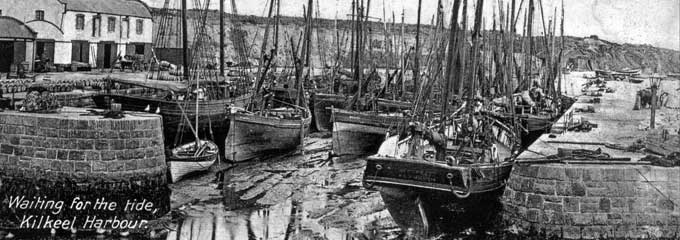
In 1740 Harris, in his History of County Down, described Kilkeel as “a small village and a church situated between the foot of the mountains of Mourne and the sea, in a narrow vale, which extends for some miles along the coast: the soil good, and the country well inhabited”. Steeped in a strong industrial tradition of fishing, farming and granite, Kilkeel takes its name from the old church overlooking the town, it being the anglicised version of the Gaelic “Cill Choal” dating back to the 14th Century. Kilkeel is the principal town in the Kingdom of Mourne.
1. The Lower Square
The site was formerly a Church of Ireland School House “Kilmorey National School” dating back to the 1840s, which was demolished and replaced by a Parochial Hall in the 1950s. The Hall was opened on 31 July 1958. The modern Lower Square was constructed in 1997 as part of a major regeneration initiative for Kilkeel. The sculpture “Narrows Journey” was erected in 1998 and depicts the rich heritage and culture of the Kilkeel area linked to the fishing, farming and granite industries.
2. Kilkeel Riverwalk
The Kilkeel Riverwalk was established in 1998 and provides a scenic tranquil 10 minute dander to the hustle and bustle of the Kilkeel Harbour.
3. Manus’s Lane
Manus’s Lane got its name from Felix (Cunningham) Manus, whose cottage and field were on the north side of its junction with the Harbour Road. The land has been used for many decades by local fishermen, school children and the wider community as a popular short cut to the harbour from the Harbour Road and to primary/secondary schools and leisure and sports facilities. Up until recently the lane was in a very poor and dangerous state of repair but was improved and upgraded in 1999.
4. The Nautilus Centre
The Nautilus Centre is located in a prime location with panoramic views overlooking the inner harbour basin. The Centre was established in November 1997 as part of a regeneration initiative for Kilkeel and houses a conference and training suite, meeting rooms, a restaurant/café, a fresh fish and maritime craft retail outlet, 12 net stores and a net mending loft. A living celebration of Kilkeel, the Centre also houses a fishing heritage multimedia facility which tells the story of Kilkeel’s rich fishing tradition.
5. Kilkeel Harbour
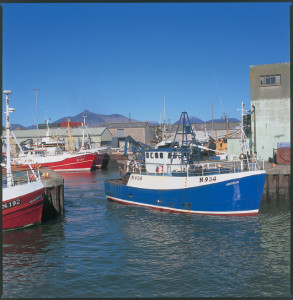 Kilkeel is home to 55% of Northern Ireland’s fishing fleet, and with over 105 boats, it boasts the largest fishing fleet in Ireland. Most varieties of fish and shellfish are landed into the port. From a historical perspective, there were always fishermen in Kilkeel and the surrounding district and the fishing industry has been, and continues to be, part of the local tradition of the area and the mainstay of the local economy. At the end of the last century the harbour, where, the oldtimers will tell you “the gardens used to grow”, got its big pier. Steeped in a strong history of being the Kingdom’s principal fishing port, it is hard to imagine that for three quarters of the 19th Century Annalong boasted a far superior port. It was not until the late 19th Century that, following the erection of a small pier and dock, Kilkeel proved to be a particularly convenient location to land catches and quickly attracted boats from all over the British Isles. This resulted in further growth and physical development at the harbour and in 1890 alone more than one third of all herring landed in Ireland came through Kilkeel. The first decades of the 20th Century brought the recession, but with the inception of motorised boats more powerful than any sail-assisted vessel, with seine nets, the decline was reversed. The 1970s saw a substantial extension of the harbour to the west and the diversion of the river into its upper end. Today Kilkeel’s fishing industry remains a vibrant one, and the harbour is a hive of commercial activity with fish processing factories, marine engineer, ice factory, fish market, and ship repair works. A key tourism attraction, many visit the harbour to see the spectacular sight of the boats coming in after a fishing expedition.
Kilkeel is home to 55% of Northern Ireland’s fishing fleet, and with over 105 boats, it boasts the largest fishing fleet in Ireland. Most varieties of fish and shellfish are landed into the port. From a historical perspective, there were always fishermen in Kilkeel and the surrounding district and the fishing industry has been, and continues to be, part of the local tradition of the area and the mainstay of the local economy. At the end of the last century the harbour, where, the oldtimers will tell you “the gardens used to grow”, got its big pier. Steeped in a strong history of being the Kingdom’s principal fishing port, it is hard to imagine that for three quarters of the 19th Century Annalong boasted a far superior port. It was not until the late 19th Century that, following the erection of a small pier and dock, Kilkeel proved to be a particularly convenient location to land catches and quickly attracted boats from all over the British Isles. This resulted in further growth and physical development at the harbour and in 1890 alone more than one third of all herring landed in Ireland came through Kilkeel. The first decades of the 20th Century brought the recession, but with the inception of motorised boats more powerful than any sail-assisted vessel, with seine nets, the decline was reversed. The 1970s saw a substantial extension of the harbour to the west and the diversion of the river into its upper end. Today Kilkeel’s fishing industry remains a vibrant one, and the harbour is a hive of commercial activity with fish processing factories, marine engineer, ice factory, fish market, and ship repair works. A key tourism attraction, many visit the harbour to see the spectacular sight of the boats coming in after a fishing expedition.
6. Mourne Esplanade
The Mourne Esplanade represents the key recreational and sporting area in Kilkeel with the Kilkeel Recreation Centre, swimming pool and state of the art fitness gym, multipurpose floodlit synthetic pitch, outdoor bowling green, tennis courts and kiddies play areas.
7. Knockchree Avenue
Knockchree Avenue is one of the main access routes into the town centre and Greencastle Street from the Mourne Esplanade and the harbour area. Kilkeel High School, which was constructed in 1953, is situated on the Avenue with a pupil enrolment of 791. The High School is one of three secondary schools in Kilkeel. Percy French, the prolific writer of songs, including the internationally renowned and loved “The Mountains of Mourne”, paid private visits to the home of Dr and Mrs Samuel Floyd who used to live in what is now 18 Knockchree Avenue.
8. Kilmorey Square
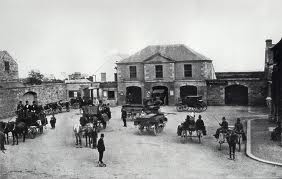 At the top of Knockchree Avenue is the Kilmorey Arms Hotel which has provided lodgings and accommodation since before the 1850s. In the 1800s the Market House and Court House were also situated at the top of the present day Knockchree Avenue where a market was held every Wednesday and fair held on the first Tuesday of every quarter. Long cars and horse drawn coaches once collected and deposited passengers from the Court House and offices. With the arrival of motorised buses, Norton & Co Bus Depot was situated in one of these buildings. The Court House was also a neutral meeting place where “Penny Readings” concerts and dances took place in the 1800s and early 1900s. The Market House was demolished in 1952. Kilmorey Square was recently improved as part of a major Environmental Improvements Scheme to the town in 1999 and is the location of an old watering trough which dates back to the 1800s. The trough was a gift to the town by Ellen Constance Lady Kilmorey and was originally situated at the corner of the Harbour Road and Bridge Street. It was used by cattle, horses and sheep until the 1960s when it was removed to its present site. A memorial statue was erected just below Kilmorey Square in 1999.
At the top of Knockchree Avenue is the Kilmorey Arms Hotel which has provided lodgings and accommodation since before the 1850s. In the 1800s the Market House and Court House were also situated at the top of the present day Knockchree Avenue where a market was held every Wednesday and fair held on the first Tuesday of every quarter. Long cars and horse drawn coaches once collected and deposited passengers from the Court House and offices. With the arrival of motorised buses, Norton & Co Bus Depot was situated in one of these buildings. The Court House was also a neutral meeting place where “Penny Readings” concerts and dances took place in the 1800s and early 1900s. The Market House was demolished in 1952. Kilmorey Square was recently improved as part of a major Environmental Improvements Scheme to the town in 1999 and is the location of an old watering trough which dates back to the 1800s. The trough was a gift to the town by Ellen Constance Lady Kilmorey and was originally situated at the corner of the Harbour Road and Bridge Street. It was used by cattle, horses and sheep until the 1960s when it was removed to its present site. A memorial statue was erected just below Kilmorey Square in 1999.
9. Kilkeel Library
Kilkeel Library was constructed in the early 1970s. The entrance to the library was the former site of the old Kilkeel Urban District Council Offices. The Urban District Council was abolished in the 1970s with the establishment of the Newry and Mourne District Council. The library car park is now the venue for the Kilkeel monthly market.
10. Parochial House/Oratory/St Colman’s
The Roman Catholic Parochial House on the corner of the Manse Road was built in 1890 on a site formerly known as “The Circus Field”. Our Lady of the Angels Oratory is a small church built at the beginning of the 1960s. It replaced an older building and is a minor Roman Catholic chapel to the main St Colman’s Church on the Newry Road. St Colman’s Hall, positioned beside the Oratory, was once the parish centre for concerts, dances and drama up until recent years. It is now used as a youth facility. St Colman’s School replaced Dunavan School on the Newry Road in 1963. The boys and girls schools amalgamated in 1989.
11. Mourne Abbey
The name Mourne Abbey refers to a Moravian religious house originally located here dating from 1763. The community was built up mainly by Brother James O’Harril, who was not ordained, but ministered there from 1797 until 1807, when he died and was buried here. It dwindled over the next 10 years. There was originally a graveyard behind the house; however this has been covered over the last century, leaving the last headstone which is now built into an outhouse wall. The inscription reads: “O’Harril – The Rev’d James O’Harril, born in Drumall Feb 27 1739 – departed June 10 1807”. The old buildings were incorporated soon after into the house of Quinn Henry who was agent to the Kilmorey Estate. This Victorian house is presumably the “delightful summer residence” referred to in the “Picturesque Handbook” (1846).
Mourne Abbey, Kilkeel
12. The Banking Tradition
The Northern Bank, situated on Greencastle Street, is a Victorian house which was previously the Belfast Bank established in 1868. The First Trust Bank, also situated on Greencastle Street, was formerly the Provincial Bank which amalgamated with the Munster and Leinster Bank in the early 1900s. It is on the site of two former cottages. The Munster and Leinster Bank was formerly situated in the building adjoining Christ Church House which was built in the 1920s. The Bank of Ireland is located at 19 Greencastle Street.
13. Mourne Presbyterian Church
Mourne Presbyterian Church was completed in 1831 at a cost of £850, replacing an old thatched three corner church which was built in 1756 and a former meeting house constructed in 1736 at the upper end of the present graveyard. The present church has been improved and renovated on several occasions. Within the grounds, in front of the church, is an old sundial which was presented to the congregation in 1757 by the son of the first known Minister of Mourne, Rev Charles Wallace. In 1923 a War Memorial was placed in front of the church. A marble figure representing a soldier with arms reversed stands on a granite base and marble pedestal. The unveiling ceremony was performed by the Rt Hon The Earl of Kilmorey and the Very Rev Major General Simms. Adjoining the church is a lecture hall which was opened originally as a school in 1853. This building is now used as a church hall.
14. Buildings of Interest Greencastle/Newry Street
At the bottom of Newry Street (John Quinn Limited; McErlane) at numbers 4-6 are two listed buildings which date back to 1790. Originally a three-storey five-bay house with one extra at the western end, the ground floor is now in shops fronts but the upper floors are all Georgian-glazed. The house was the former home of Dr Adderly.
15. The Church of Christ
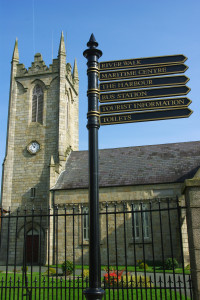 Christ Church , Church of Ireland was consecrated in the year 1815. It stands between Newry Street and Mountain Road. It has been considerably improved since it first opened. Tablets in the church include one to the soldier and explorer General Francis Rawdon Chesney of Packolet House, Ballyardle. He was born at Ballyveagh Annalong in 1789 and died at Packolet just outside Kilkeel in 1872. He devoted the last 20 years of his life to literary and scientific pursuits, including the furtherance of the great project of the Euphrates line to India and the surveyance of the feasibility of the Suez Canal which now links the Mediterranean with the Red Sea. He is buried in the cemetery at Christ Church. The graveyard also contains graves of many other local notables, including the Kilmorey family and Robert Scott (d 1961) who won a VC in the Boer War.
Christ Church , Church of Ireland was consecrated in the year 1815. It stands between Newry Street and Mountain Road. It has been considerably improved since it first opened. Tablets in the church include one to the soldier and explorer General Francis Rawdon Chesney of Packolet House, Ballyardle. He was born at Ballyveagh Annalong in 1789 and died at Packolet just outside Kilkeel in 1872. He devoted the last 20 years of his life to literary and scientific pursuits, including the furtherance of the great project of the Euphrates line to India and the surveyance of the feasibility of the Suez Canal which now links the Mediterranean with the Red Sea. He is buried in the cemetery at Christ Church. The graveyard also contains graves of many other local notables, including the Kilmorey family and Robert Scott (d 1961) who won a VC in the Boer War.
16. Mourne Hospital/Workhouse
Probably the “Handsome House” referred to in the “Picturesque Handbook” (1846) described as “lately erected”, Mourne Hospital was once the Fever Hospital attached to the Workhouse. The Housing Estate (Ben Crom etc) and Brooklands Nursing Home are built directly on the site. When the latter closed, part of the building was used first as an integrated post primary school (Mourne Higher Grade School) from 1918-1925, and then as a technical school until the new college building was built on Greencastle Street. The building was also used by the RUC “A” Specials as a barracks in the early 1920s and by Dr Barnardos House during the 1940s. At the rear of the workhouse and hospital are the “Burying Banks” which mark the site of many unmarked graves of paupers and workhouse inmates.
The Old Mourne Hospital/Workhouse
17. The Knitting Factory
Erected by the very Rev Richard Marner DDPP in 1889, Kilkeel Knitting Mills was formerly St Colman’s “Dunavan” Roman Catholic male, female and infant National Schools up to 1963. St Colman’s School is now located on Greencastle Street.
18. St Louis Grammar School
St Louis Grammar School was founded in 1921. It was previously known as “Thornmount” which was owned by McClymot who had sawmills there. Additions were made to the school in 1973 and it now houses 573 pupils (1999). There is an old fort behind the school which is of rich archaeological interest.
19. St Colman’s Roman Catholic Church
The Church of St Colman (Massforth) is the Roman Catholic Church which stands about a mile from Kilkeel on the Newry side of the town. It is close by the Mass Rock used in the Penal days and replaced an earlier small chapel. It was completed in 1879, replacing an older building dated 1810, and was designed by architect John O’Neill & Byrne. The church was erected through the dedication of the Very Rev Richard Marner DDPP VF who was born in the parish of Kilmore 1834. Mr Marner was Professor and President of St Malachy’s College Belfast (1857-1876) and Parish Priest of Upper Mourne (1885-1906). He also led the building of the Church at Atticall; Parochial House and Hall on Greencastle Street, Kilkeel; St Colman’s; Star of the Sea and Atticall Schools. He died in 1906.
In the field behind the cemetery there is a “Kistavaen” or “Giants Grave” which is of significant archaeological interest.
20. Site of The Old Royal Hotel, Bridge Street
In the 1830s the Police Barracks was located on the site with six policemen. The building was then renovated and extended by “Clondyke Rooney” who was a well known beneficiary of the early US Goldrush at Clondyke. The building traded as “The Royal Hotel” up until the mid 1980s when it was burned in a fire and remained derelict up until 2000 when it was redeveloped into commercial, retail and office premises.
21. The Old Church of St Colman’s and Graveyard
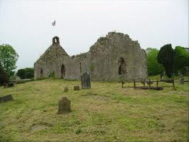
The Old Church represents the historic monument from which Kilkeel takes its name, translated to mean “The Church of the Narrow Place”. Its location, on an elevated narrow site, would appear to confirm this. Dating back to the 14th Century, the church was dedicated to St Colman and was known in 1388 as “St Colman Del Morne”. Within the grounds of the church there is a defaced equal armed medieval cross, which stands beside a granite socket stone, which was traditionally used as a wart well for curing warts. A detailed historical description of the tradition, folklore and structure of the church and surrounding graveyard are available on the interpretive boards in the graveyard.
22. Site of The Old Temperance Hotel
The current Housing Executive building on Newcastle Street was the former site of the old Temperance Hotel where Percy French used to stay on his many visits to Kilkeel. As noted, Percy French also frequented the home of Dr and Mrs Samuel Floyd on Knockchree Avenue.
23. The Alfred Eadie Hall/Kilkeel Presbyterian Hall
The United Brethren Meeting House on Newcastle Street, now the Alfred Eadie Hall, was originally a Moravian Church until 1916. It was erected in 1832 and its foundation stone with the inscription “Church of the United Brethren 1832” is built into the porch of the present day manse. It was then used as a church hall by Kilkeel Presbyterian Church, which is further down Newcastle Street beside the Housing Executive. The church was formed by the Secession Presbytery of Markethill in 1822. The present church replaced an older building at the end of the 19th Century. In recent years it has undergone extensive renovations and had a steeple added.
24. Other Ecclesiastical Associations
The recently constructed Baptist Tabernacle stands at the edge of the town on Newcastle Road. The former tabernacle, which stood on an elevated site opposite where the new structure is positioned, was built in 1933. The Brethren have their Meeting House on the Mountain Road. It was built in 1932. There is also a Brethren Meeting House on Newcastle Street. The Mourne Free Presbyterian Church is on the outskirts of Kilkeel on the Newcastle side of the town on the Carginagh Road.
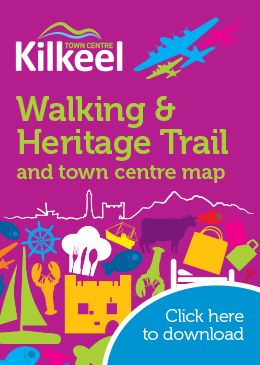



Follow Us